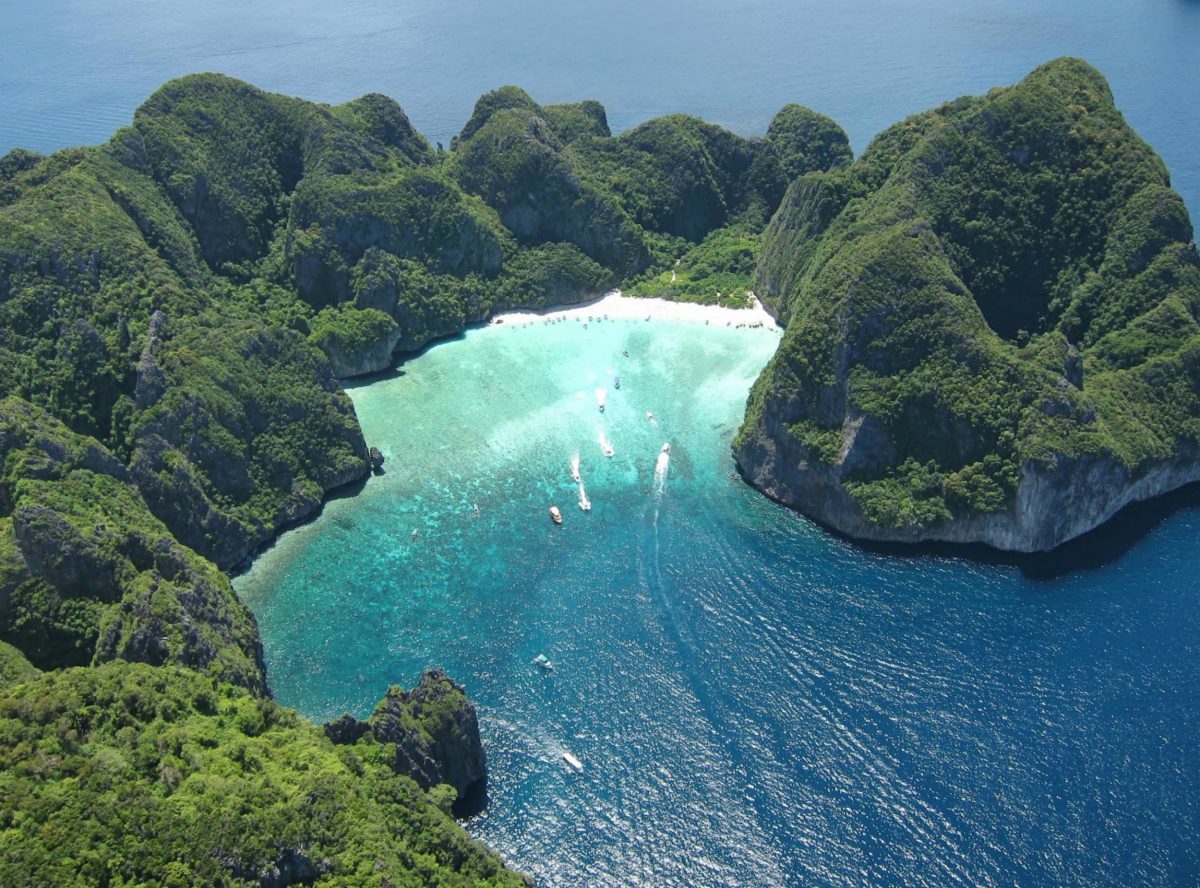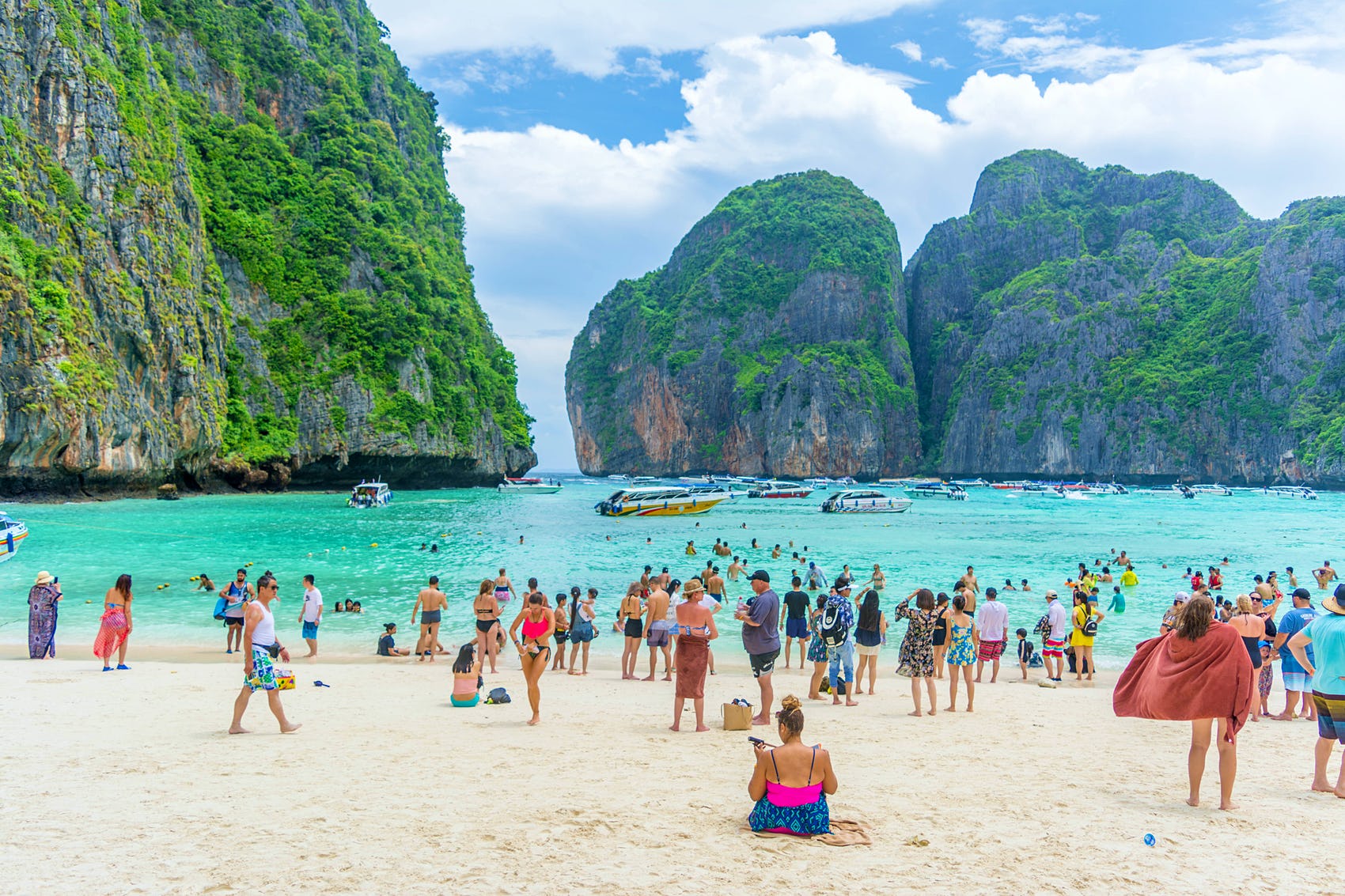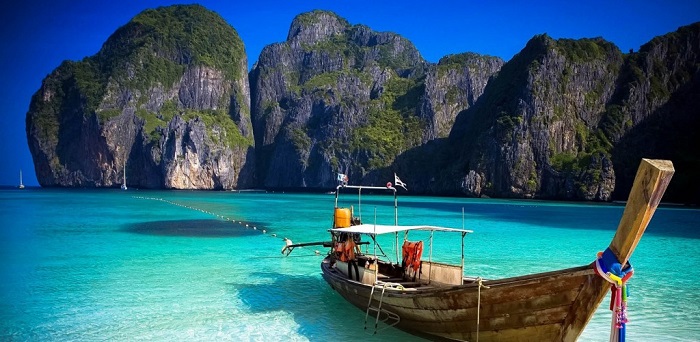
Maya Bay, Thailand: Reclaiming Paradise, Echoes of "The Beach" and a Hopeful Future

Maya Bay. The name alone conjures images of pristine white sand, towering limestone cliffs, and turquoise waters shimmering under the tropical sun. This idyllic cove, nestled on the uninhabited island of Phi Phi Leh in Thailand, achieved global fame after its starring role in the 2000 film "The Beach," catapulting it to a must-see destination for travelers worldwide. However, the very popularity that the film brought almost led to its demise, prompting a crucial period of reflection and rehabilitation. Today, Maya Bay stands as a testament to the delicate balance between tourism and environmental preservation, offering a hopeful narrative of recovery and sustainable practices.
The Allure of "The Beach": A Cinematic Paradise Found (and Lost)
Before Maya Bay became a household name, it was a relatively unknown gem in the Andaman Sea. Then came Danny Boyle’s adaptation of Alex Garland’s novel, "The Beach." The film, starring Leonardo DiCaprio, depicted a group of young backpackers seeking an unspoiled paradise, a secret haven away from the well-trodden tourist trails. Maya Bay, with its breathtaking beauty and secluded atmosphere, was chosen as the film’s primary location, perfectly embodying the utopian ideal at the heart of the story.
The impact of the film was immediate and profound. Millions of viewers were captivated by the visuals of Maya Bay, drawn to its promise of escape and adventure. The film’s success transformed the bay from a hidden treasure into a global icon, attracting an unprecedented influx of tourists eager to experience the "paradise" they had seen on screen.
However, the sudden surge in tourism took a heavy toll on the fragile ecosystem of Maya Bay. The sheer volume of visitors, coupled with unsustainable tourism practices, led to significant environmental degradation. Coral reefs were damaged by boat anchors and careless swimmers, the beach was littered with waste, and the natural tranquility of the bay was disrupted by the constant noise and activity.
The environmental impact was so severe that in 2018, Thai authorities made the difficult but necessary decision to close Maya Bay to tourists. This closure was not a punishment, but a crucial intervention aimed at allowing the bay’s ecosystem to recover and regenerate.
A Period of Healing: The Rehabilitation of Maya Bay
The closure of Maya Bay marked a turning point in its history. It provided an opportunity for scientists, conservationists, and local communities to work together to rehabilitate the bay’s damaged ecosystem. A comprehensive restoration plan was implemented, focusing on several key areas:

Coral Reef Restoration: Coral reefs are the foundation of marine ecosystems, providing habitat and food for a wide variety of marine life. The coral reefs in Maya Bay had suffered significant damage from boat anchors, pollution, and physical contact. To address this, a coral propagation program was initiated, involving the transplantation of healthy coral fragments onto damaged reefs. This process helped to accelerate the natural recovery of the coral reefs and restore their biodiversity.
-
Beach Restoration: The beach itself had also suffered from erosion and pollution. The restoration efforts included the removal of accumulated waste, the stabilization of the shoreline, and the replanting of native vegetation. These measures helped to restore the natural beauty of the beach and protect it from further degradation.
-
Infrastructure Improvements: To manage tourism more effectively in the future, improvements were made to the infrastructure around Maya Bay. A new pier was constructed away from the main beach to reduce the impact of boat traffic on the coral reefs. Elevated walkways were built to guide visitors and prevent them from trampling on sensitive vegetation.
-
Sustainable Tourism Practices: A key component of the rehabilitation plan was the implementation of sustainable tourism practices. These practices included limiting the number of visitors allowed into the bay each day, promoting responsible behavior among tourists, and educating visitors about the importance of environmental conservation.
Reopening with a New Vision: Sustainable Tourism in Action
After more than three years of closure and intensive rehabilitation efforts, Maya Bay reopened to tourists in January 2022, but with a new vision for sustainable tourism. The reopening was carefully managed, with strict regulations in place to protect the environment and ensure a positive experience for visitors.
The new regulations include:
- Limited Visitor Numbers: The number of visitors allowed into Maya Bay each day is strictly limited. This helps to reduce the pressure on the environment and prevent overcrowding.
- Designated Swimming Areas: Swimming is only allowed in designated areas to protect the coral reefs and other sensitive marine habitats.
- No Boat Anchoring: Boats are not allowed to anchor directly in Maya Bay. Instead, they must use designated mooring buoys located away from the coral reefs.
- Waste Management: Strict waste management protocols are in place to prevent pollution and ensure that the beach remains clean and pristine.
- Environmental Education: Visitors are provided with information about the importance of environmental conservation and how they can help to protect Maya Bay’s ecosystem.
The reopening of Maya Bay with these sustainable tourism practices represents a significant step forward in the effort to balance tourism and environmental preservation. It demonstrates that it is possible to enjoy the beauty of natural wonders without destroying them in the process.
Beyond the Postcard: The Reality of Tourism and Conservation
The story of Maya Bay serves as a powerful reminder of the complex relationship between tourism and conservation. While tourism can bring economic benefits to local communities, it can also have a devastating impact on the environment if not managed responsibly.
The Maya Bay case highlights the importance of:
- Sustainable Tourism Planning: Careful planning is essential to ensure that tourism development is sustainable and does not harm the environment. This includes setting limits on visitor numbers, implementing responsible tourism practices, and investing in environmental protection.
- Community Involvement: Local communities should be actively involved in the planning and management of tourism. This helps to ensure that tourism benefits local people and that their voices are heard.
- Environmental Education: Educating tourists about the importance of environmental conservation is crucial. This can help to promote responsible behavior and encourage visitors to respect the environment.
- Continuous Monitoring and Evaluation: It is important to continuously monitor and evaluate the impact of tourism on the environment. This allows for adjustments to be made to management practices as needed.
The Legacy of "The Beach": A Double-Edged Sword
The film "The Beach" undoubtedly played a significant role in shaping the destiny of Maya Bay. On one hand, it brought global recognition and economic opportunities to the region. On the other hand, it contributed to the environmental degradation that nearly destroyed the bay.
The legacy of "The Beach" is therefore a double-edged sword. It serves as a cautionary tale about the potential negative impacts of tourism, but also as a source of inspiration for sustainable tourism practices.
Visiting Maya Bay Today: A Responsible Traveler’s Guide
If you are planning a visit to Maya Bay, here are some tips for being a responsible traveler:
- Book in Advance: Due to the limited number of visitors allowed each day, it is essential to book your visit in advance.
- Choose a Responsible Tour Operator: Select a tour operator that is committed to sustainable tourism practices.
- Respect the Environment: Follow the rules and regulations in place to protect the environment.
- Do Not Litter: Dispose of your waste properly and avoid bringing single-use plastics.
- Be Mindful of Marine Life: Avoid touching or disturbing marine life.
- Support Local Businesses: Patronize local businesses that are committed to sustainable practices.
- Educate Yourself: Learn about the history and ecology of Maya Bay before your visit.
By following these tips, you can help to ensure that your visit to Maya Bay is both enjoyable and sustainable.
Maya Bay: A Symbol of Hope
Maya Bay’s journey from cinematic paradise to environmental crisis and back to a symbol of hope is a testament to the power of collective action and the importance of sustainable tourism. While the scars of past mismanagement may still be visible, the bay’s remarkable recovery offers a valuable lesson for other destinations facing similar challenges.
Maya Bay’s story is not just about a beach; it’s about the delicate balance between human ambition and environmental preservation. It’s a reminder that paradise is not a given, but something that must be actively protected and nurtured. As visitors return to its shores, they carry with them not just memories of breathtaking beauty, but also a responsibility to ensure that Maya Bay remains a thriving ecosystem for generations to come. The iconic vibes of "The Beach" may still linger, but they are now intertwined with a deeper understanding of the fragility of paradise and the importance of protecting it.
The Future of Maya Bay: A Continued Commitment to Sustainability
The reopening of Maya Bay is not the end of the story, but rather the beginning of a new chapter. The Thai authorities and local communities remain committed to ensuring the long-term sustainability of the bay.
Future plans include:
- Continued Monitoring and Research: Ongoing monitoring and research will be conducted to track the health of the ecosystem and identify any potential threats.
- Community Empowerment: Efforts will be made to empower local communities to play a greater role in the management of Maya Bay.
- Promoting Eco-Tourism: Eco-tourism initiatives will be promoted to encourage responsible travel and support local conservation efforts.
- International Collaboration: Collaboration with international organizations and experts will continue to ensure that Maya Bay is managed according to best practices.
Maya Bay’s story is a reminder that even the most damaged ecosystems can be restored with dedication and effort. It is a symbol of hope for the future of tourism and a testament to the power of human ingenuity and resilience. As visitors from around the world return to its shores, they will find not just a beautiful beach, but also a story of recovery, sustainability, and the enduring power of paradise reclaimed. The echoes of "The Beach" will forever be a part of its history, but now they are accompanied by a new narrative: one of responsibility, respect, and a commitment to preserving this natural wonder for generations to come.





